How To Use The Camera On The Iphone 8
In addition to improvements in the native Camera and Photos apps, iOS 8 brings a host of new capabilities that tin be used by third-party photographic camera apps to put more than ability into the hands of the iPhone photographer. In this article, you'll notice how to these new iPhone manual camera controls to have incredible photos.
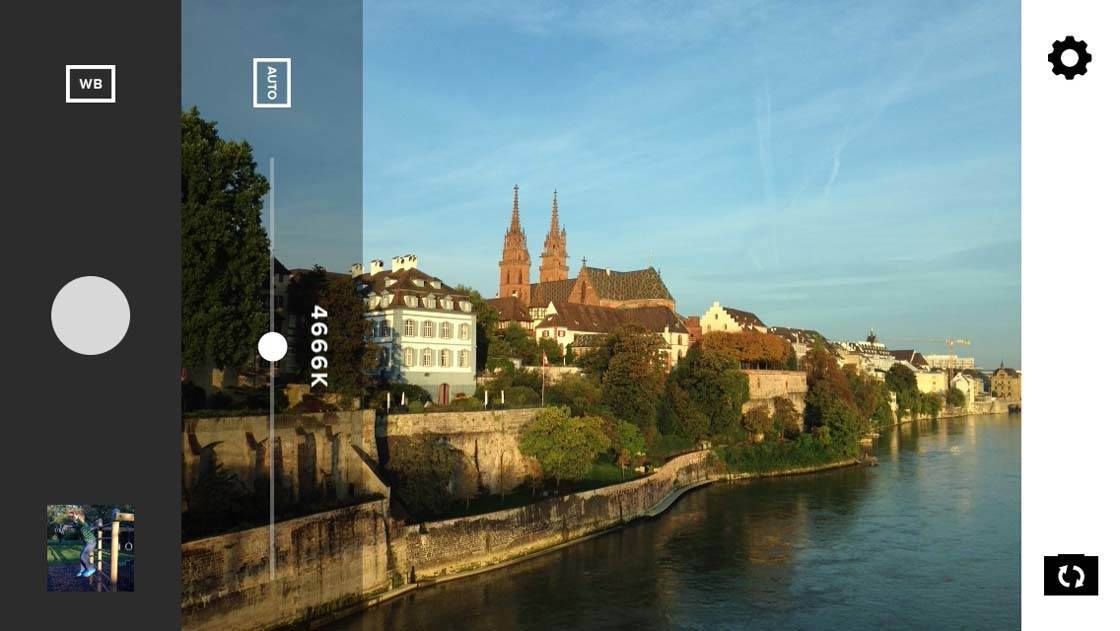
iOS 8 was released on September 17, and at that place's been a lot of excitement about the new manual exposure controls now available in the native Camera app.
But iOS viii also enables 3rd-political party camera apps to offer a whole range of new transmission capabilities, namely:
- Exposure compensation
- Transmission exposure
- Manual focus
- Manual white remainder
- Bracketed capture
This is very exciting for photographers! These new manual controls will give u.s.a. DSLR-similar control over our iPhones, enabling us to attain better exposure and get more artistic with our photography.
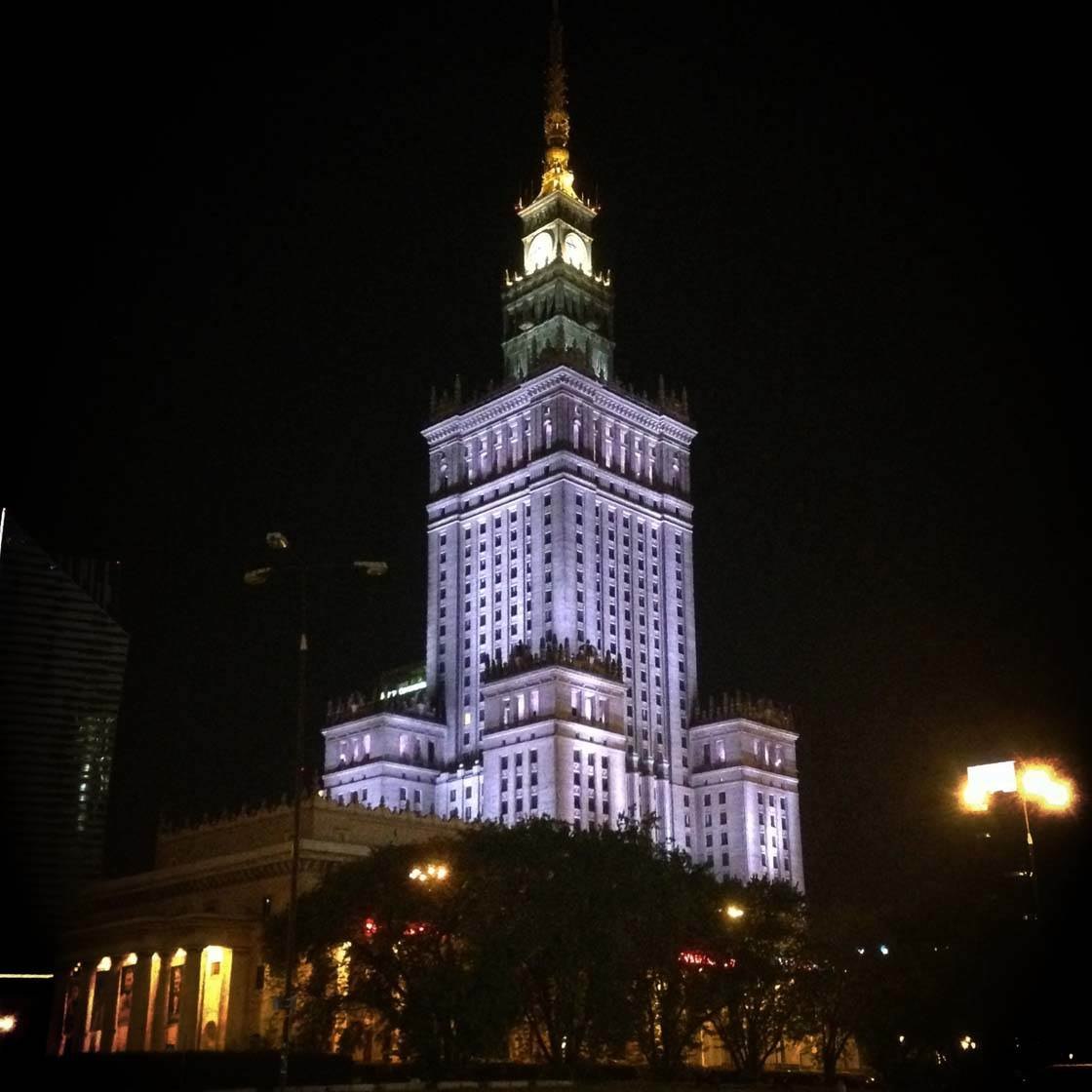
Over the next few weeks we expect many tertiary-party camera apps to be updated to support manual camera controls in a meaningful mode. VSCO, which is the best free photographic camera app for iPhone (aside from the born Camera app) was amidst the first to update their camera apps.
Also, watch out for new apps, such as Manual, that are being created solely to back up manual camera controls.
Permit's take a expect at these new manual camera capabilities in a language that everyone can understand, and see how they tin improve your photographic workflow.
Exposure Bounty
Exposure determines the amount of light that reaches the camera's sensor, and therefore affects how bright or dark the photo will be. Exposure is controlled past 3 parameters:
- Aperture – the size of the opening in the lens determines how much lite reaches the sensor
- Shutter speed – how much fourth dimension the shutter is open up for determines how much low-cal reaches the sensor
- ISO – the parameter determining how sensitive the sensor is to light
On the iPhone, the aperture is a fixed size then this tin can't be used to change exposure. However, shutter speed and ISO tin can be altered to manually arrange the exposure of a photo.
The longer the shutter speed, the brighter the photograph will be. The higher the ISO, the brighter the photo will exist.
If you're using the native Camera app and you've tapped the screen to set focus (or you've used tap and agree to lock focus/exposure), you'll see a vertical yellow line with a little xanthous sunday icon on the correct of the focus box.
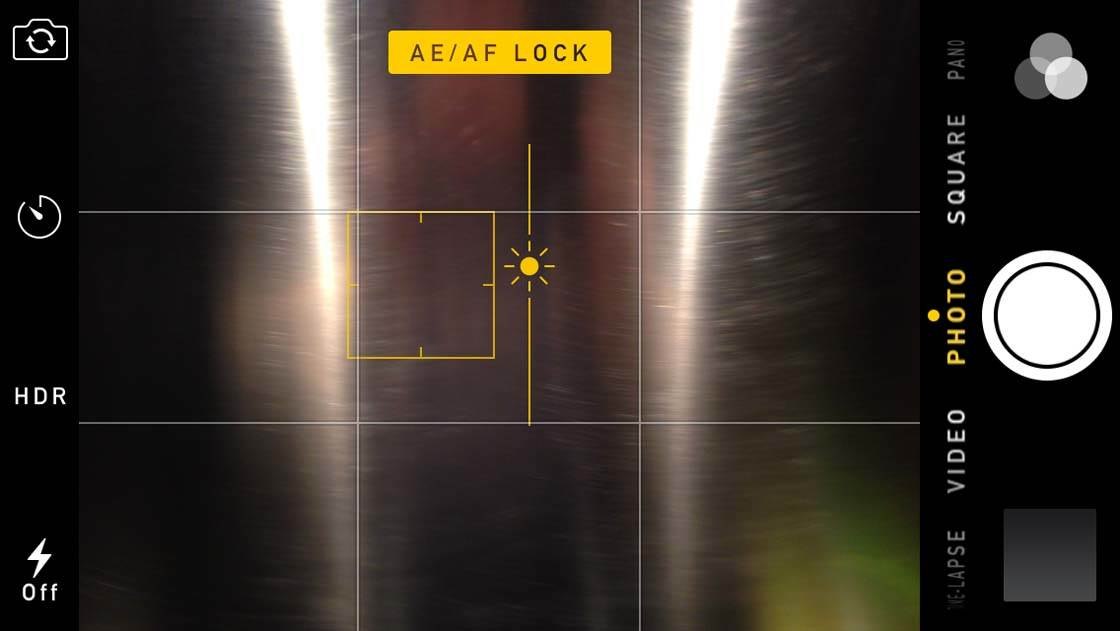
Swipe upward to increase the exposure or swipe downwardly to subtract the exposure. You lot'll see the event immediately on the screen. Tapping elsewhere on the screen volition reset the exposure to the automatic values.
By swiping the sun icon in either direction, we're telling the camera to intentionally over-betrayal or under-expose the photo to adjust our personal taste. The camera will automatically apply a suitable shutter speed and ISO setting to become the exposure you want.
Exposure compensation in the native Camera app is very convenient, and I would highly recommend that you start using information technology to expand your photographic workflow on your iPhone.
Manual Exposure
Transmission exposure allows the photographer to command the values of shutter speed and ISO manually. This gives you a lot more artistic freedom when taking photos, as opposed to letting the camera make up one's mind these values for you.
The VSCO app really shines here because it offers semi-automatic modes. For example, yous tin can set up the shutter speed manually, and the app will adapt the ISO accordingly to achieve the correct exposure.
Or vice versa – you set the ISO manually, and the app adjusts the shutter speed accordingly. There'south too a full manual mode where you tin can modify both parameters to your liking, with all of its pros and cons.
Beware of what power is at your disposal though! Just a handful of shutter speed/ISO combinations will result in well-exposed photos. The rest will evangelize either under-exposed or over-exposed photos that you won't be able to correct in mail service-processing.
And then, when would command over shutter speed be useful? Remember, shutter speed is the amount of fourth dimension that the shutter stays open for when taking a photo. Usually, you adjust shutter speed to change how the camera captures motion in the scene.
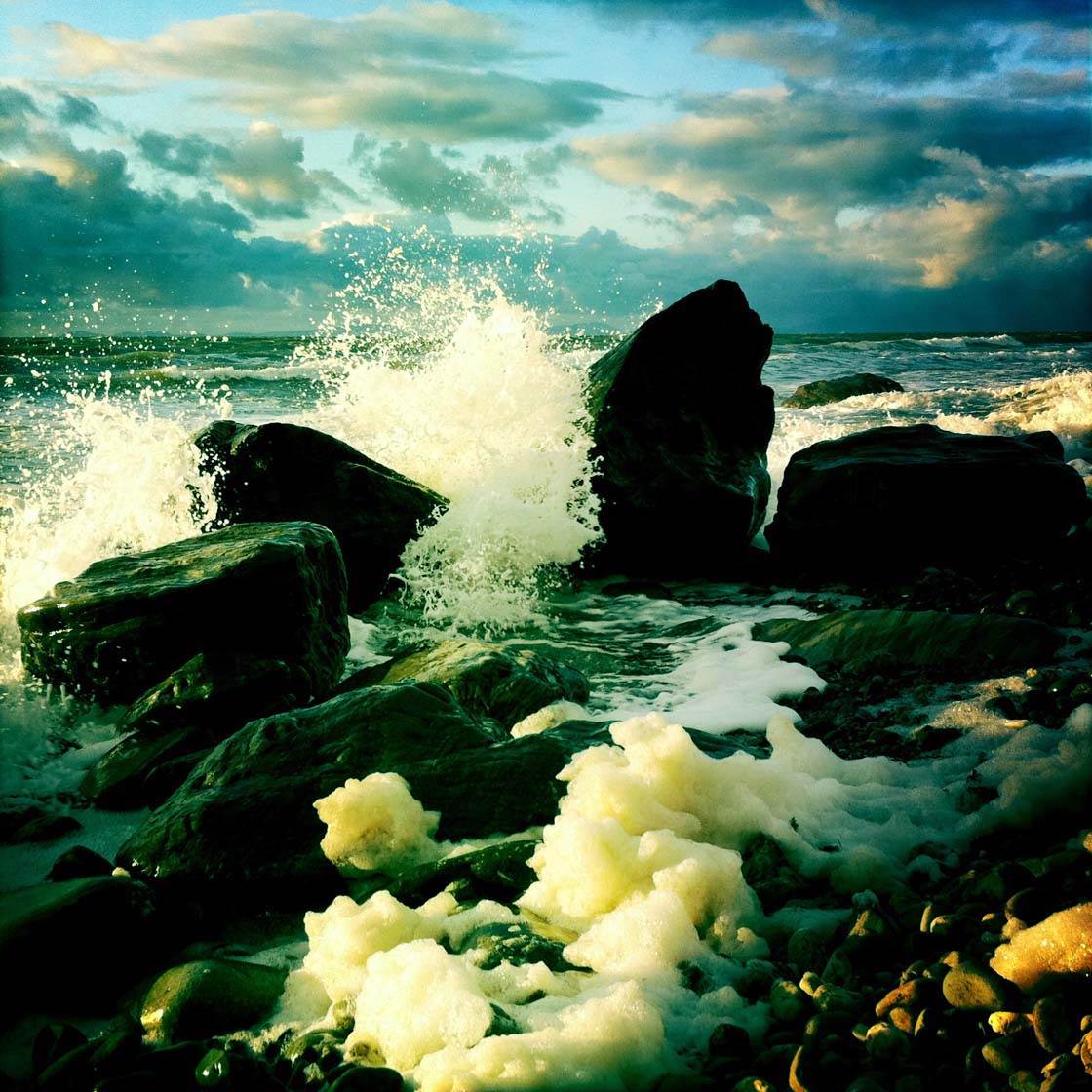
A fast (brusk) shutter speed is used to freeze whatever motility, for example, a person riding a wheel or the individual water aerosol of the crashing wave equally shown in the photo to a higher place.
A slow (long) shutter speed is used for long exposure photography to deliberately blur any motility. For example, to create intentional blur of a auto speeding past to convey how fast information technology was traveling. This type of blur is referred to as motion blur.
Slow shutter speeds are also used to create the soft veiling consequence on flowing water that yous can meet in the waterfall photo below.
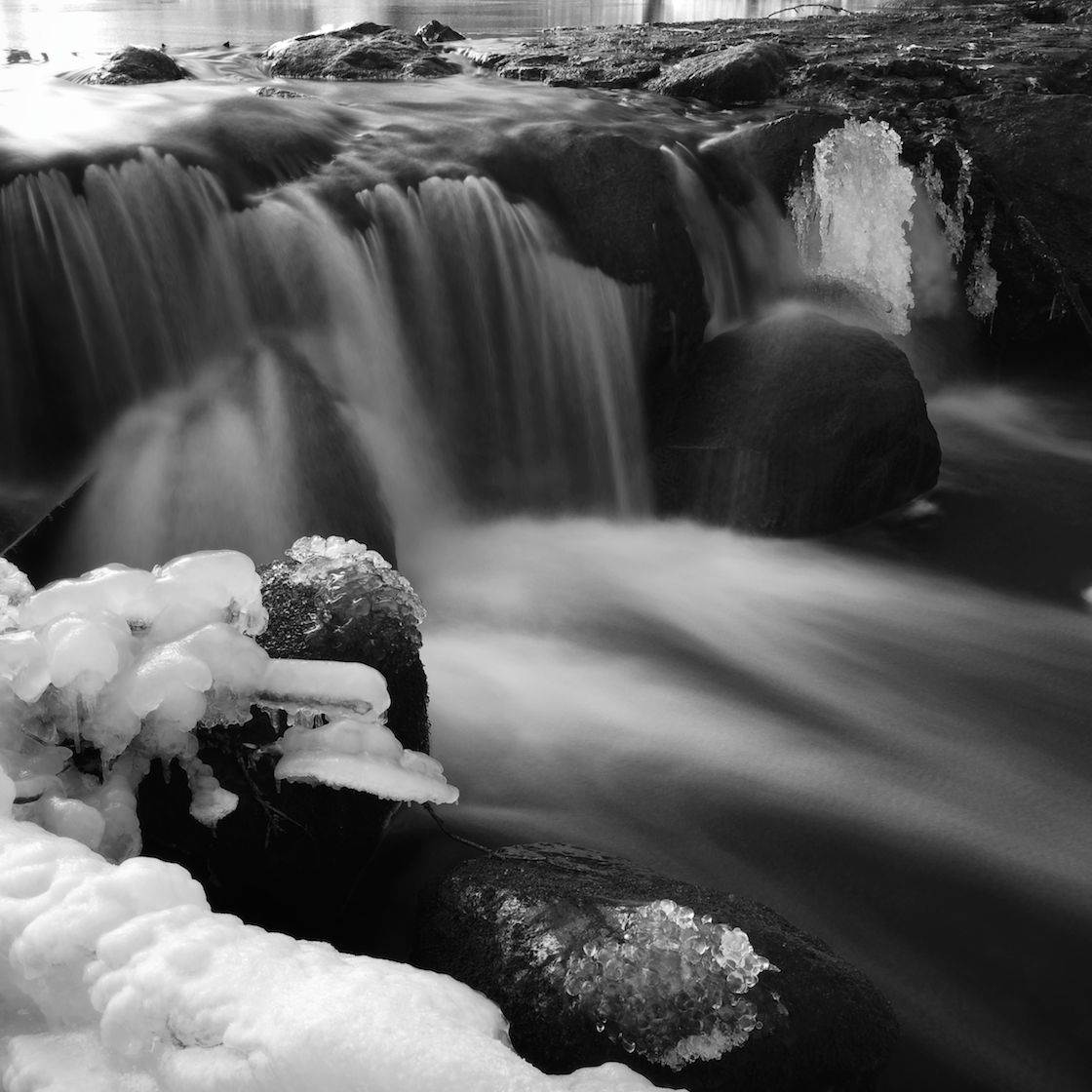
What about ISO? When would yous want manual control over that? Remember, ISO controls the camera'south sensitivity to light. The higher the ISO, the more sensitive to calorie-free it volition be, and therefore the brighter the exposure will be.
With this in mind, you should be able to work out that yous could use a college ISO in low light situations to increment the exposure without having to use a slower shutter speed.
So you can capture fast moving subjects in low lite without them actualization blurry. Or you can mitt-hold the photographic camera in low low-cal without getting blurry photos from camera shake.
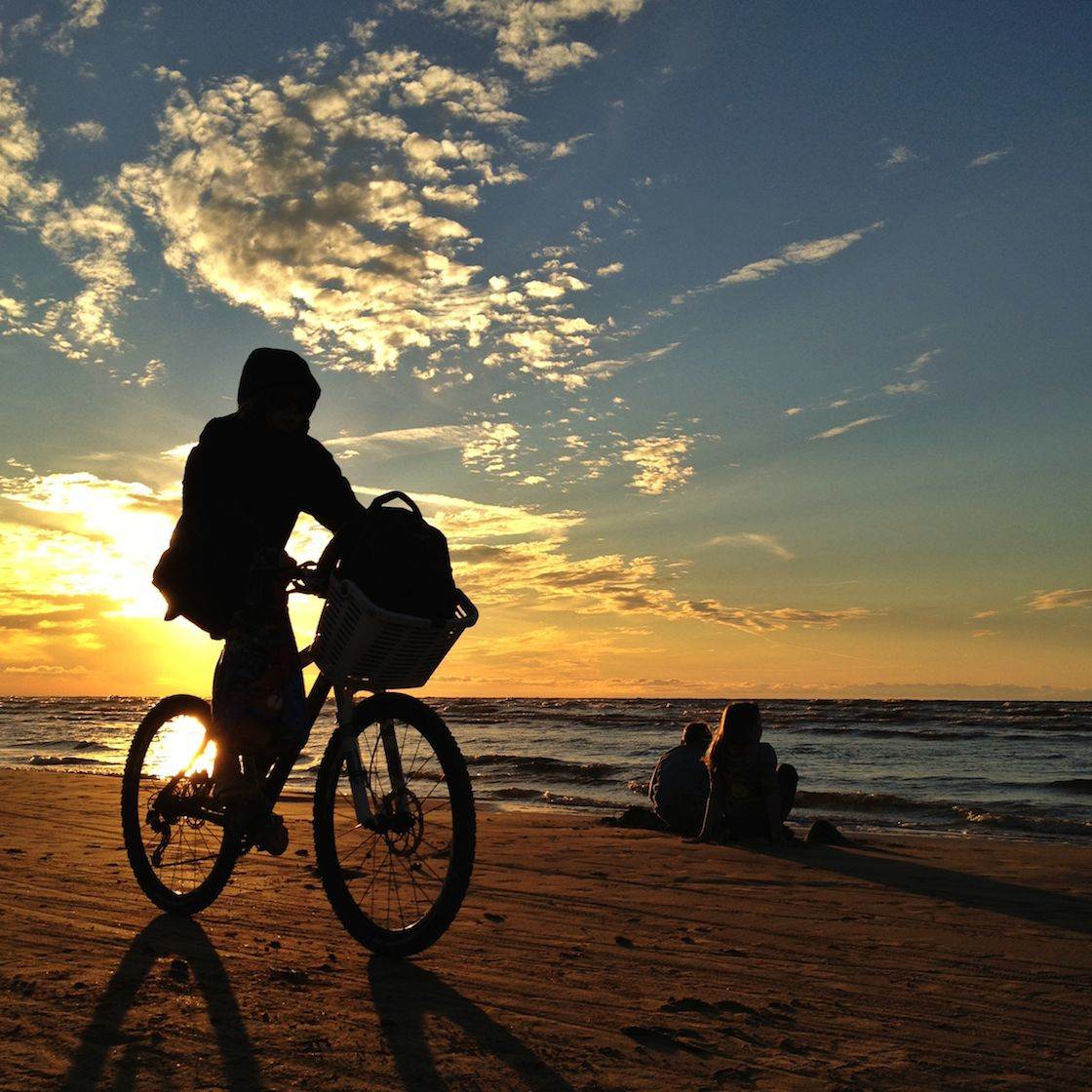
However, yous must carry in mind that using high ISO values tin result in digital racket, which is seen every bit colorful grain in your photos. This tends to reduce the quality of your photos and isn't seen as a desirable attribute.
Every bit a photographer, you must decide what'due south more important – a abrupt photo with no noise, but where moving subjects appear blurred. Or a grainy photograph where the subject's movement is frozen.
If there's no move in a depression calorie-free scene and you can put your camera on an iPhone tripod or other steady surface, it's best to go on the ISO at a low value and employ a longer shutter speed to expose the photograph correctly. This volition limit the grain in your photograph.
Equally a photographer, you'll probably use full manual exposure style relatively seldom. Achieving the correct exposure parameters tin exist time consuming, fifty-fifty when you fully understand what you're doing. Then if your scene is not static, you'll well-nigh certainly miss the shot.
Therefore, I recommend that you use the semi-automatic modes in VSCO, where y'all set either shutter speed or ISO, and the app sets the other value for you in order to achieve a right exposure.
The semi-automated modes provide you with more than creative possibilities than fully automatic manner, but the app supports you on the style, so you can set your desired exposure much faster.
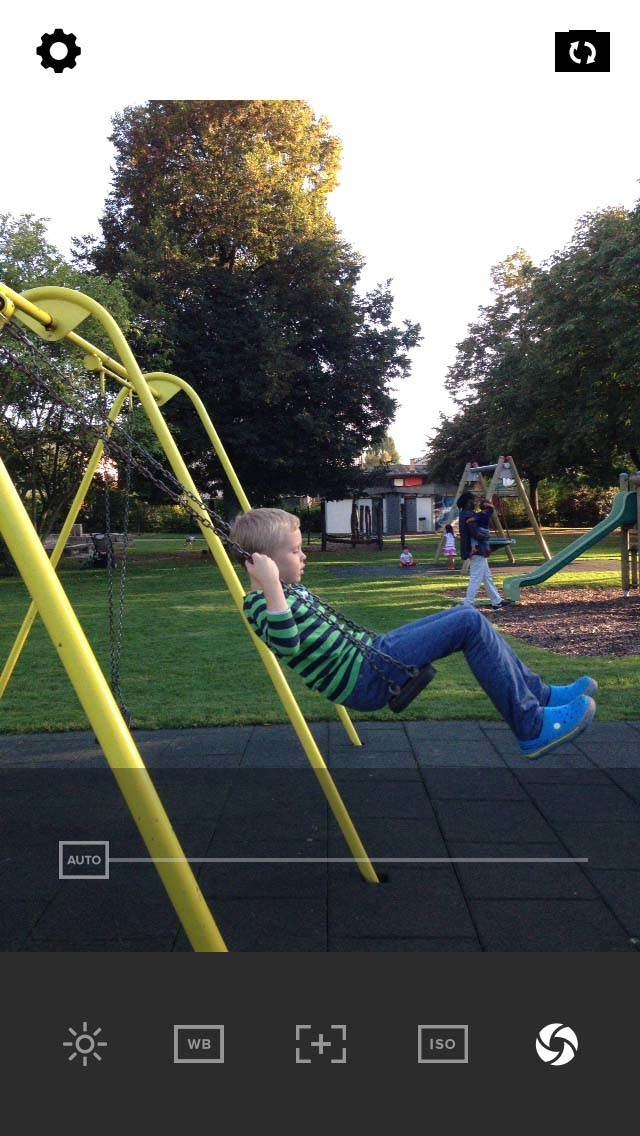
In the picture to a higher place you can see VSCO in the transmission shutter speed fashion. The icons in the lesser bar requite you access to the sliders for each manual control.
From left to right, the icons are: exposure bounty, manual white balance, manual focus, transmission ISO and transmission shutter speed. The lilliputian "Auto" push on the left of the slider lets yous toggle between automated and transmission mode for the setting.
In this item example I moved the shutter speed slider all the way to the left to to use a very fast shutter speed. This immune me to freeze the movement in the scene.
The automated setting would have used a slower shutter speed, resulting in the moving subject actualization equally a blur.
Manual Focus
Manual focus allows you to control the aeroplane where the photographic camera sets its focus (chosen "hyperfocal point" in photography speak).
Earlier iOS 8 you were merely able to tap the part of the screen where yous wanted focus to be set, and the iPhone would do its best to make that part focused (and too well exposed).
In iOS viii it's possible to arbitrarily prepare the focus to a given value, enabling you to accurately focus on the foreground or the background, or anywhere in between.
Manual focus can prove useful when yous struggle to become the focus on the right area. For example, if you're photographing through a store window, the camera oftentimes ends up focusing on the nearest airplane which is the glass of the window.
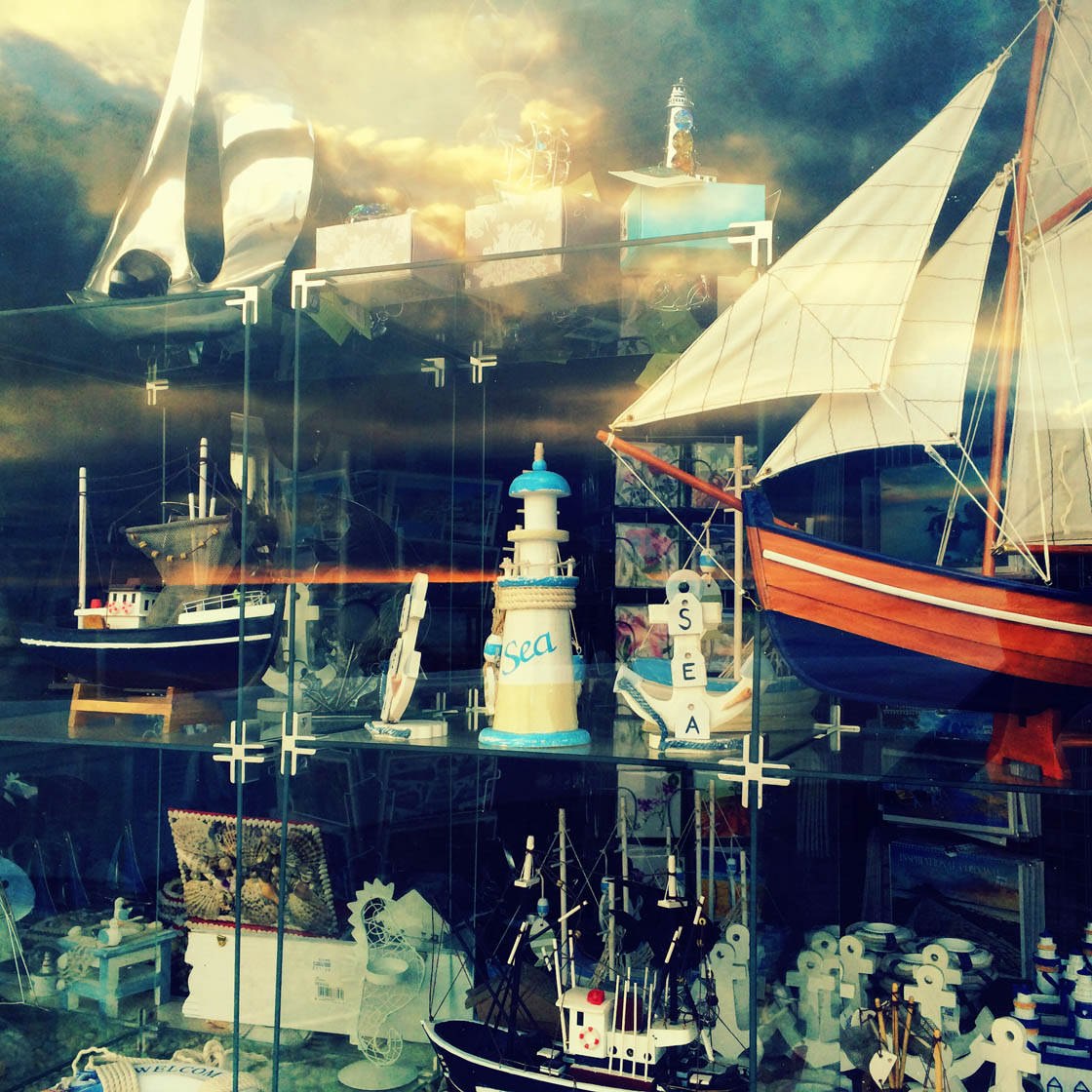
By using manual focus, you're able to motility the focus indicate past the glass and put it onto the items behind the window.
As a photographer, you probably won't use the transmission focus pick very oft. It'due south normally easier to tap to focus, and even if the camera doesn't focus well the first time, simply repeat the process and tap once again.
Using manual focus can prove useful in macro photography when y'all desire to have full control over what is in abrupt focus and what is not.
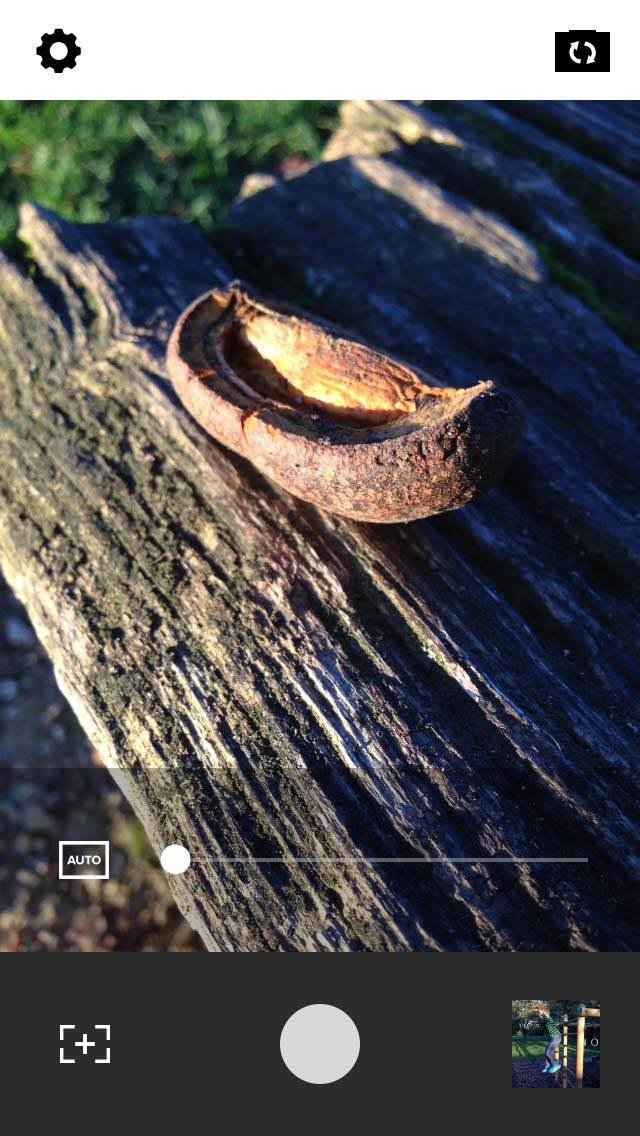
The higher up picture shows the manual focus way in VSCO. I moved the slider all the way to the left, which immune me to capture the detailed texture of the quondam tree in the foreground.
I didn't accept to fight with the inaccurate tap-to-focus technique that is normally quite cumbersome in macro photos. I was in full command.
Hint: when using manual focus, it's all-time to stabilize the camera past putting it on the steady surface, or preferably on a tripod. Specially when taking macro photos, even the slightest movement can put the photo out of focus again.
Transmission White Balance
White balance determines how the colors in a scene are reproduced in the digital picture. Different types of light produce different colour casts based on their colour temperature. These color casts have an result on how those colors announced in your photo.
For example, candle light produces a warm orange colour cast, so the colors in your photograph will appear warmer (more orange) than normal. Which is why when you take a photograph of a lovely candle-lit dinner, that white tabular array cloth oftentimes appears orange.
By dissimilarity, taking a photograph in outdoor shade produces a absurd bluish colour cast, so the colors in your photo will announced cooler (more blue) than normal. Which is why when you take a photo of a beautiful snowy woodland scene, the snow often appears blue.
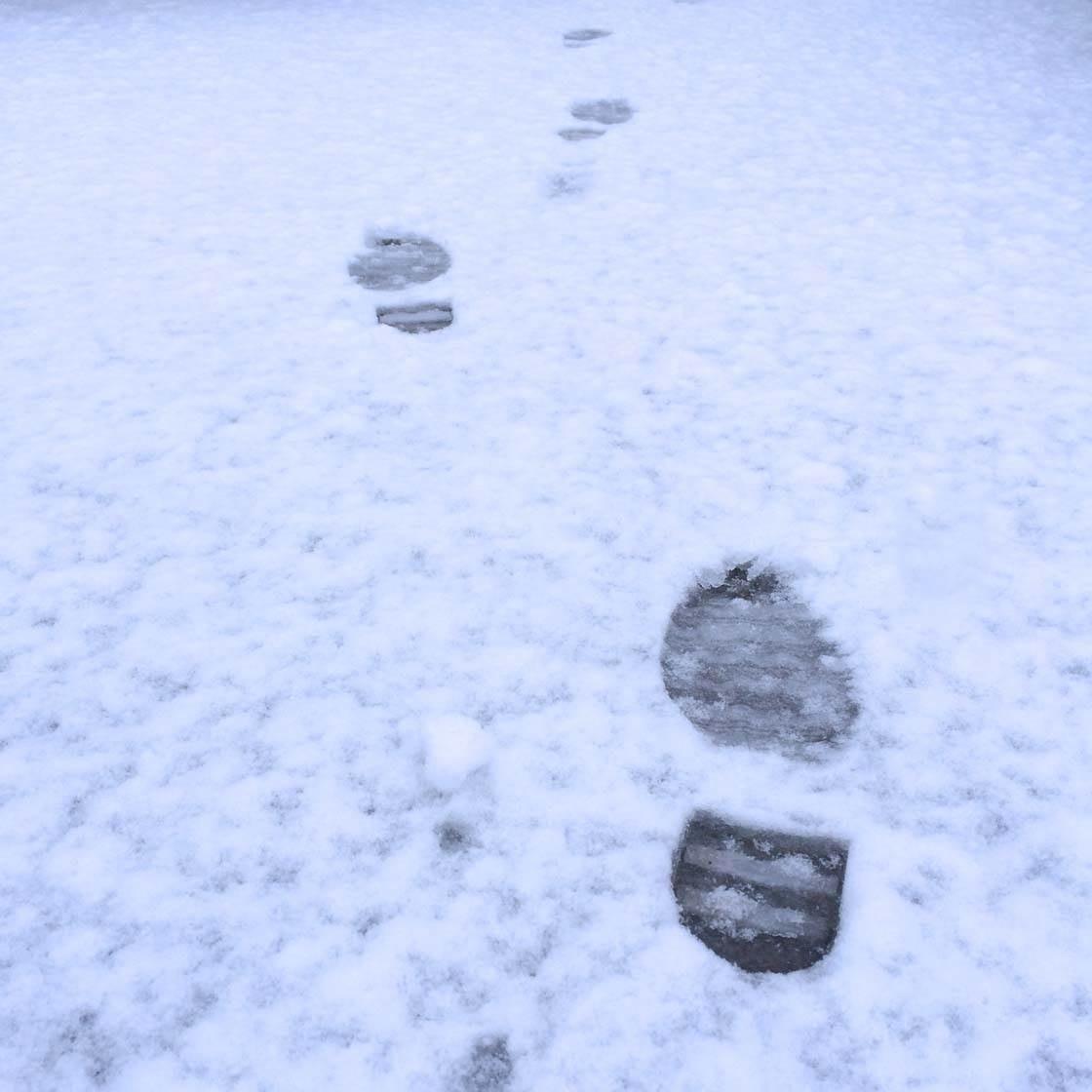
Luckily, the white balance feature in digital cameras can neutralize these color casts by warming upwardly or cooling downward the colors. The iPhone's camera actually does a very good job of automatically setting white residual for the scene.
Merely in certain lighting situations information technology doesn't exercise so well, and in these instances y'all demand more transmission control over the white residual, so that your whites appear white and all of the other colors are reproduced accurately.
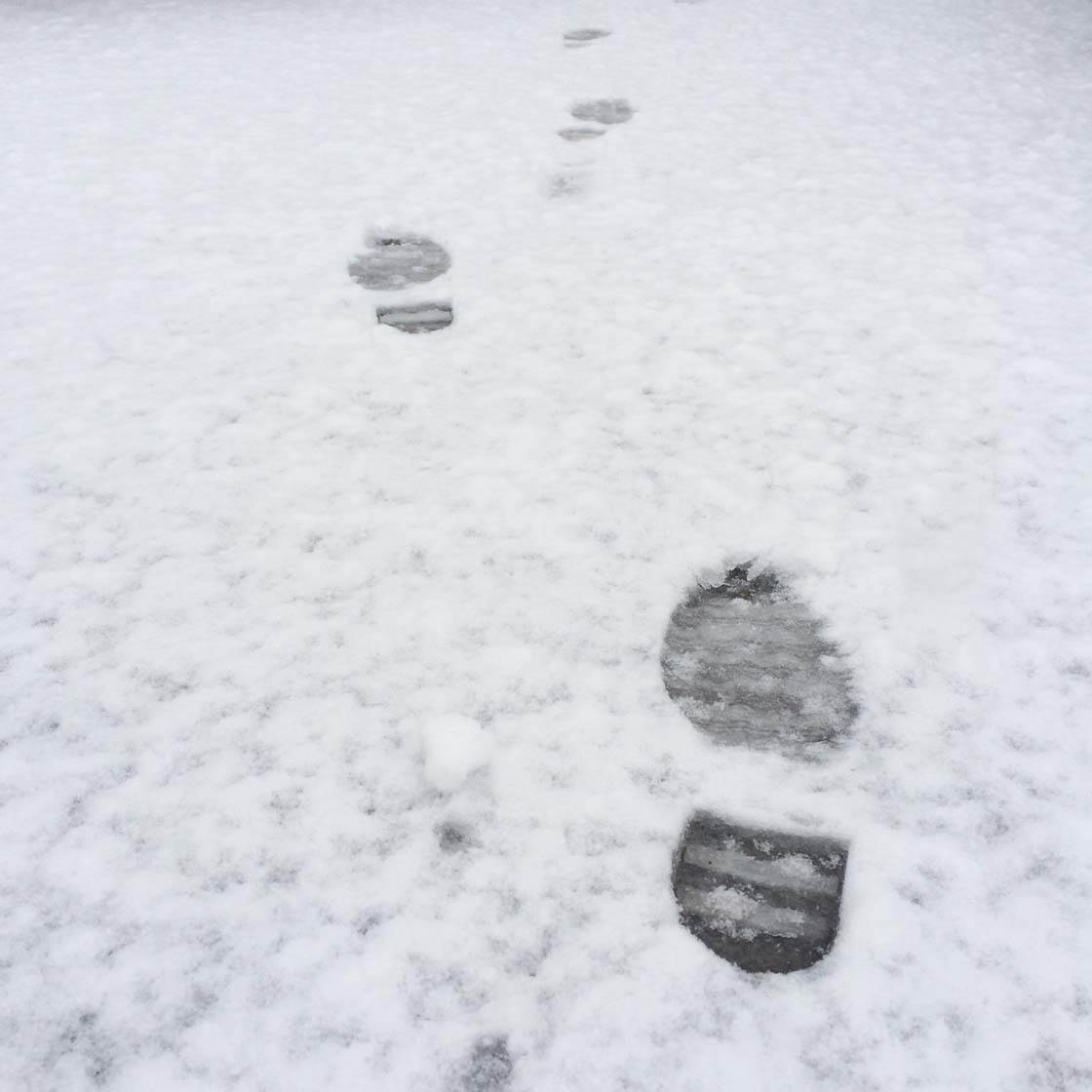
So far, iPhone apps (apart from iPhoto) weren't able to set a custom white balance for the scene. In iOS eight this changes, and third-party apps can now permit total manual command of the white rest.
White balance, or color temperature, is measured in Kelvin degrees (K), which sounds abstract for the majority of people shooting photos with the iPhone.
Therefore some apps like Camera+ six.0 (non withal released) have decided to offer photographers a ready of useful presets which can exist used to speedily accommodate the white balance to the relevant lighting weather condition. The presets are called:
- Motorcar (default setting)
- Sun
- Cloudy
- Flash
- Shadow
- Incandescent Low-cal
- Fluorescent Light
You lot simply select the relevant option for the type of lighting you're shooting in, and it should remove whatever color cast from that light. It'southward also possible to set manual white residue, but this is quite an avant-garde technique requiring the employ of gray card.

The moving picture above shows the manual white residual mode in VSCO. I used this mode to bump up the colour temperature a flake.
Despite the fact it was early morning and the colors were looking rather cool, I was able to warm them up a scrap to give the viewer the impression that the lord's day has fully risen.
As a photographer, yous would definitely want to utilise manual white remainder when doing commercial photography, especially product or nutrient photography, where proper color reproduction is key to the success of the photograph session.
But likewise think nigh using information technology any fourth dimension a photograph appears too cool or also warm. It really can make the globe of difference to your photos.
Bracketed Capture
Bracketed capture is an automatically initiated serial of photos. In that location are 2 scenarios for bracketing. The offset is when all of the photos in the series are taken with the aforementioned settings – in this case we telephone call it burst subclass.
The second bracketing scenario is when the photos are taken with different settings. If the serial of photos are taken using different exposure compensation settings, then information technology's chosen auto exposure bracket.
If the photos are taken with different shutter speeds or ISO values, then it's called manual exposure bracket.
The native Camera app uses bracket mode quite frequently. It uses it in outburst style when you lot shoot a series of photos in quick succession by property downwards the shutter button.
And information technology uses it in the cocky-timer mode when it shoots a serial of 10 photos so that you tin cull the best one.
Information technology also uses bracket mode in depression light conditions, where it automatically shoots a burst of several photos and tries to stabilize them digitally to remove blur.
And finally, it uses it for HDR photos when you lot have the HDR option switched on in the native Camera app. In this case, the camera shoots the with different exposure settings and merges these photos together to reach wider tonal range in the final photograph.
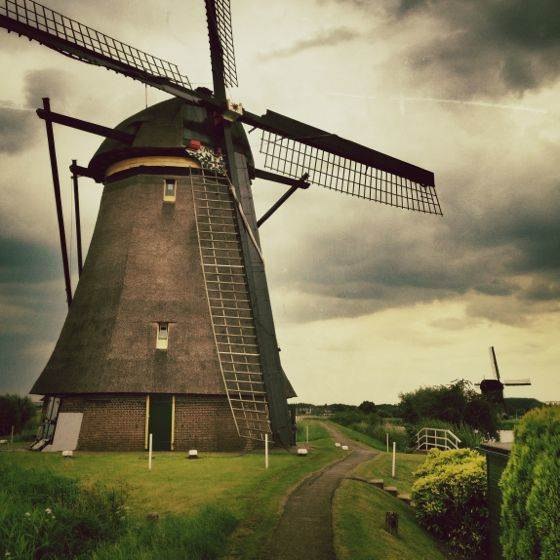
Some third-party HDR photo apps, such equally vividHDR have announced plans to utilize subclass capture to speed up the process of taking HDR photos.
As a photographer, you won't have to worry well-nigh the details of bracket capture besides frequently. It's merely expert to know that it's in that location and that it can be used to your reward.
About The Writer
Michal Szklanowski is a Smoothen enthusiast iPhone photographer currently living in Basel, Switzerland.
Michal is an active member of the Polish mobile photography collective "Grupa Mobilni" and has published numerous Polish and English language articles on mobile photography.
His photos accept been exhibited several times in Poland, and two of them got an Honorable Mention in the 2014 IPPA Awards contest. You can reach Michal via Instagram or on the Grupa Mobilni website.
Source: https://iphonephotographyschool.com/ios-8-manual-camera-controls/
Posted by: metcalfparturly.blogspot.com

0 Response to "How To Use The Camera On The Iphone 8"
Post a Comment